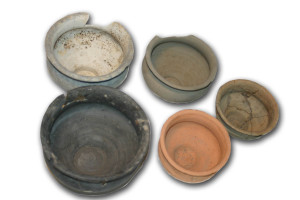This project investigated the emergence and development of wheel-thrown pottery in the Germanic Babaricum from the second half of the 2nd c. AD. In the course of the study, a large series of surviving ceramics underwent geochemical and other archaeoceramological analyses, in order to determine the spatial distribution of the various production sites. The goal of the project was to reveal the economic structures underlying this distribution.
Research
Wheel-thrown pottery technology was introduced into the Germanic Barbaricum in the second half of the 2nd c. AD. Together with the potter’s wheel, another new element emerged: a double-chamber kiln with a vent-holed floor, which enabled wheel-thrown ceramics to be fired at higher temperatures.
The appearance of this technological package is limited to an area around 400 km from the limes, in which three regions can be delimited:
- In the area between the Rhineland and Thuringia, vessels were produced in the Roman tradition, while native forms continued to be produced by hand.
- In the area between the Elbe and the Vistula/San, a portion of native vessel forms were produced using the potter’s wheel.
- In the area between the Dniester and the Black Sea, almost a full spectrum of ceramics was produced using the potter’s wheel.
Due to the complexity of the production process, it was until now the common belief, that wheel-thrown pottery manufacture requires concentrated production at a limited number of sites. Furthermore, the finished products must then be distributed – a necessity that did not arise in the case of homemade ceramics. Hence, large series of wheel-thrown pottery from selected regions (see below) were scientifically analyzed in order to determine the spatial distribution of the various production sites. The focus lay on geochemical analyses of clay using portable x-ray fluorescence analyzers, accompanied by refiring analyses and more precise laboratory-based x-ray fluorescence analyses, and including mineralogical analysis of tempering and study of porosity and firing temperature. This enables us to identify the products of a particular pottery workshop and to expose the space-related economic structures. The interpretation of these structures as well as the clarification of the economic mechanisms underlying them, was this project’s most important goal.
First Results
Research area Eastern Germany
In the Imperial Era sites between the Elbe and the Oder only a small amount of wheel-thrown pottery have been found among the total of ceramic finds. The first pilot study indicated distribution routes of more than 80 km. In order to verify this conclusion, further studies were conducted. For this purpose, the primal study area was extended. In addition to brandenburgian sites, further sites in Eastern Saxony were examined. Apart from explicit distribution patterns indicating a specialized production, parallel patterns of local small scale production could be detected as well.
An interesting new insight has arisen due to the comparison of pottery from sites and graves. Here, obviously, different economic mechanisms were at work.
Research area Ukraine
In the region of the Chernyakhov culture, wheel-thrown pottery comprised the largest share of total ceramic production. Two regions (Olbia and its surrounding rural settlements, as well as Voitenky) were examined to determine the extent of centralized production and distribution of ceramics.
According to this analysis, two different cultural induced economic patterns were revealed: specialized pottery production and distribution in the Graeco-Roman period (1st – 3rd century CE) and pottery made of site-specific clay in obviously local household (?) production with various workshops/potters per site in the Chernyakhov period (3rd – 4th century CE).
General Conclusion
The study proved a) for Eastern Germany and the Ukraine centralized production and distribution patterns, but b) local small scale production as well. Therefore – in contrary to the previous expectation – wheel-thrown pottery cannot automatically be regarded as products of a highly-specialized craft in these regions. The phenomenon of different production patterns regarding pottery in graves and sites thus requires further investigation.
Parts of the project have been presented at major international conferences and workshops and published in several articles, e.g.:
Open-Access publication: Michael Meyer, Malgorzata Daszkiewicz, Gerwulf Schneider, Reinhard Bernbeck, Bernhard Heeb, Morten Hegewisch, Kay Kohlmeyer, Claudia Näser, Silvia Polla, Erdmute Schultze, Fleur Schweigart and David Warburton, “Economic Space. On the Analysis and Interpretation of Pottery Production and Distribution”, in: Space and Knowledge. Topoi Research Group Articles, eTopoi. Journal for Ancient Studies, Special Volume 6 (2016), 190–219
Cooperations
Franz Schopper (Brandenburgisches Landesamt für Denkmalpflege, Wünsdorf)
Regina Smolnik (Landesamt für Archäologie Sachsen, Dresden)
Jürgen Vollbrecht (Stadtmuseum Bautzen)
Oleg Petrauskas (Institute of Archaeology, National Academy of Sciences of Ukraine, Kiev)
Alla Bujskich (Institute of Archaeology, National Academy of Sciences, Ukraine)
Michail Ljubicev (University of Kharkiv)

